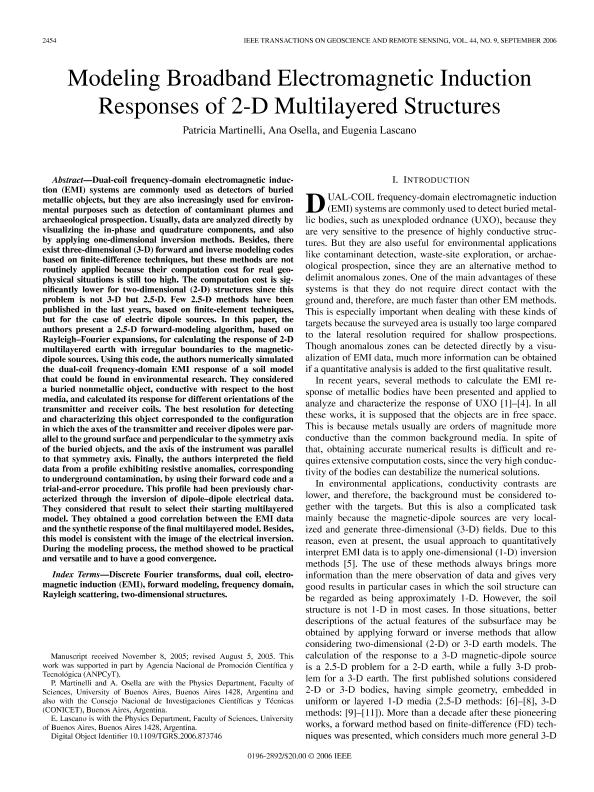Mostrar el registro sencillo del ítem
dc.contributor.author
Martinelli, Hilda Patricia

dc.contributor.author
Osella, Ana Maria

dc.contributor.author
Lascano, Eugenia
dc.date.available
2019-03-14T15:18:37Z
dc.date.issued
2006-12
dc.identifier.citation
Martinelli, Hilda Patricia; Osella, Ana Maria; Lascano, Eugenia; Modeling broadband electromagnetic induction responses of 2-D multilayered structures; Institute of Electrical and Electronics Engineers; Ieee Transactions On Geoscience And Remote Sensing; 44; 9; 12-2006; 2454-2460
dc.identifier.issn
0196-2892
dc.identifier.uri
http://hdl.handle.net/11336/71624
dc.description.abstract
Dual-coil frequency-domain electromagnetic induction (EMI) systems are commonly used as detectors of buried metallic objects, but they are also increasingly used for environmental purposes such as detection of contaminant plumes and archaeological prospection. Usually, data are analyzed directly by visualizing the in-phase and quadrature components, and also by applying one-dimensional inversion methods. Besides, there exist three-dimensional (3-D) forward and inverse modeling codes based on finite-difference techniques, but these methods are not routinely applied because their computation cost for real geophysical situations is still too high. The computation cost is significantly lower for two-dimensional (2-D) structures since this problem is not 3-D but 2.5-D. Few 2.5-D methods have been published in the last years, based on finite-element techniques, but for the case of electric dipole sources. In this paper, the authors present a 2.5-D forward-modeling algorithm, based on Rayleigh-Fourier expansions, for calculating the response of 2-D multilayered earth with irregular boundaries to the magnetic-dipole sources. Using this code, the authors numerically simulated the dual-coil frequency-domain EMI response of a soil model that could be found in environmental research. They considered a buried nonmetallic object, conductive with respect to the host media, and calculated its response for different orientations of the transmitter and receiver coils. The best resolution for detecting and characterizing this object corresponded to the configuration in which the axes of the transmitter and receiver dipoles were parallel to the ground surface and perpendicular to the symmetry axis of the buried objects, and the axis of the instrument was parallel to that symmetry axis. Finally, the authors interpreted the field data from a profile exhibiting resistive anomalies, corresponding to underground contamination, by using their forward code and a trial-and-error procedure. This profile had been previously characterized through the inversion of dipole-dipole electrical data. They considered that result to select their starting multilayered model. They obtained a good correlation between the EMI data and the synthetic response of the final multilayered model. Besides, this model is consistent with the image of the electrical inversion. During the modeling process, the method showed to be practical and versatile and to have a good convergence. © 2006 IEEE.
dc.format
application/pdf
dc.language.iso
eng
dc.publisher
Institute of Electrical and Electronics Engineers

dc.rights
info:eu-repo/semantics/openAccess
dc.rights.uri
https://creativecommons.org/licenses/by-nc-sa/2.5/ar/
dc.subject
Discrete Fourier Transforms
dc.subject
Dual Coil
dc.subject
Electromagnetic Induction (Emi)
dc.subject
Forward Modeling
dc.subject
Frequency Domain
dc.subject
Rayleigh Scattering
dc.subject
Two-Dimensional Structures
dc.subject.classification
Meteorología y Ciencias Atmosféricas

dc.subject.classification
Ciencias de la Tierra y relacionadas con el Medio Ambiente

dc.subject.classification
CIENCIAS NATURALES Y EXACTAS

dc.title
Modeling broadband electromagnetic induction responses of 2-D multilayered structures
dc.type
info:eu-repo/semantics/article
dc.type
info:ar-repo/semantics/artículo
dc.type
info:eu-repo/semantics/publishedVersion
dc.date.updated
2019-02-12T17:26:32Z
dc.journal.volume
44
dc.journal.number
9
dc.journal.pagination
2454-2460
dc.journal.pais
Estados Unidos

dc.journal.ciudad
washington
dc.description.fil
Fil: Martinelli, Hilda Patricia. Consejo Nacional de Investigaciones Científicas y Técnicas. Oficina de Coordinación Administrativa Ciudad Universitaria. Instituto de Física de Buenos Aires. Universidad de Buenos Aires. Facultad de Ciencias Exactas y Naturales. Instituto de Física de Buenos Aires; Argentina
dc.description.fil
Fil: Osella, Ana Maria. Consejo Nacional de Investigaciones Científicas y Técnicas. Oficina de Coordinación Administrativa Ciudad Universitaria. Instituto de Física de Buenos Aires. Universidad de Buenos Aires. Facultad de Ciencias Exactas y Naturales. Instituto de Física de Buenos Aires; Argentina
dc.description.fil
Fil: Lascano, Eugenia. Universidad de Buenos Aires; Argentina
dc.journal.title
Ieee Transactions On Geoscience And Remote Sensing

dc.relation.alternativeid
info:eu-repo/semantics/altIdentifier/doi/http://dx.doi.org/10.1109/TGRS.2006.873746
Archivos asociados
